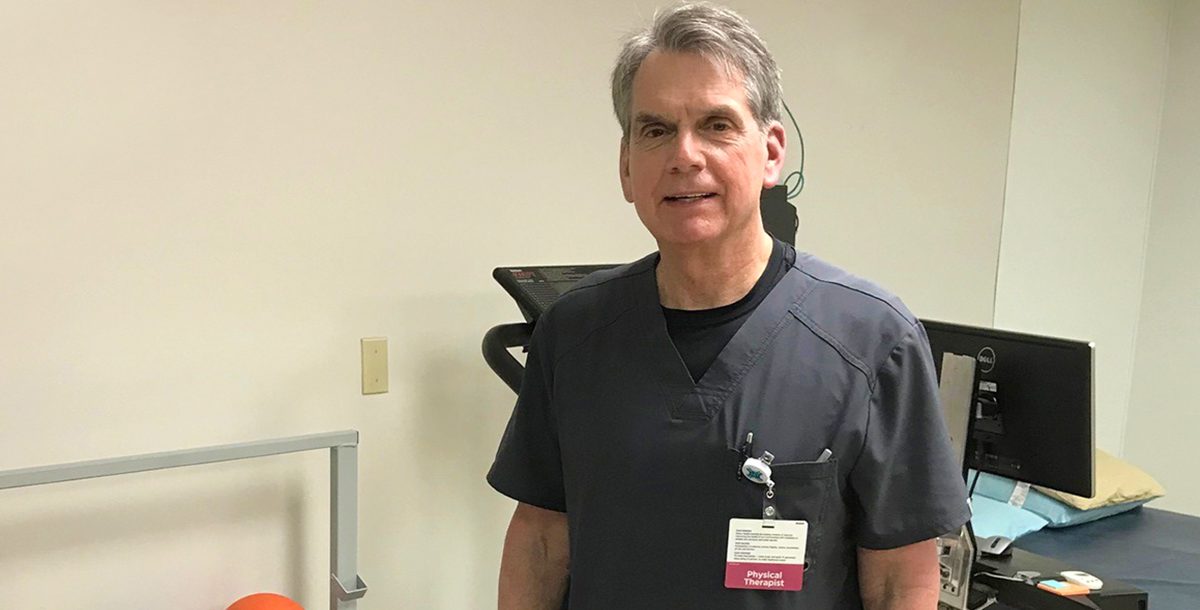While many of us hope we can age safely while living at home, data shows that falls are the number one cause of fatal and nonfatal injuries among older adults.
According to the Centers for Disease Control and Prevention (CDC), more than one-third of adults aged 65 and older fall each year in our country. These falls take a tremendous toll annually and lead to millions of emergency department visits, almost 1 million hospitalizations and thousands of deaths.
Additionally, people who survive a fall often experience lingering issues that predispose them to falling again.
“There are a lot of people living alone at home. Their family thinks they are independent because they can get a meal, but they can’t stand up by themselves, can’t walk independently and are not on an exercise program,” Mark Vance, PT, (pictured above) with the outpatient physical therapy unit at Mercy Health – Lourdes Hospital, shares. “There’s a high rate of depression and isolation in this group. Many don’t have the reserves necessary to function daily. Thus, this is the group most at risk for a fall.”
To help address this issue, specifically in the Paducah, Ky. community, Mark recently completed a program called “Balance and Falls Prevention in Community Dwelling Older Adults: An American Physical Therapy Association Geriatrics Credentialing Course Series.” This is the first time this program and credentialing have been available from the American Physical Therapy Association (APTA) in balance and falls prevention for older adults.
The first step is to understand someone’s risk for falling.
“The CDC recommends that anyone 65 and older undergo an annual screening to determine their fall risk,” Mark shares.
Doctors or physical therapists can administer the screening, which is made up of a series of 12 statements to which people answer yes or no.
The statements include:
- I have fallen in the past year.
- I use or have been advised to use a cane or walker to get around safely.
- Sometimes I feel unsteady when I am walking.
- I steady myself by holding onto furniture when walking at home.
- I am worried about falling.
- I need to push with my hands to stand up from a chair.
- I have some trouble stepping up onto a curb.
- I often have to rush to the toilet.
- I have lost some feeling in my feet.
- I take medicine that sometimes makes me feel light-headed or more tired than usual.
- I take medicine to help me sleep or improve my mood.
- I often feel sad or depressed.
A “yes” answer to questions one and two is worth two points; the rest are worth one point each. Add up the number of points for each “yes” answer. People scoring four points or more may be at risk for falling. According to the CDC Algorithm for Fall Risk Screening, Assessment and Intervention, people with a score of four points or more should receive medical screening and/or a physical therapy evaluation.
“These are the criteria for a patient to be referred for physical therapy or an evidence-based fall prevention program, if one is available locally,” Mark adds.
Physical therapists can help patients who’ve fallen or are at risk of falling by finding out what is causing the problem.
“Is it medication related? We can review that. Is it an eyesight problem? We can refer the patient to an optometrist. Leg strength is a big issue and we can work on that. Neuropathy, vestibular issues and other things can affect a person’s balance and we can address those issues. A physical therapy evaluation will determine the priorities of need based on the patient’s condition,” Mark explains.
He continues, “we see people because of the effects of a fall – a broken hip, shoulder or wrist, or a traumatic head injury. We don’t often see them for the reason for the fall. It’s something that we can address professionally, and it can make all the difference.”
Check out the CDC’s fall risk screening questions.
Also, learn more about the physical therapy programs we have at Mercy Health.






